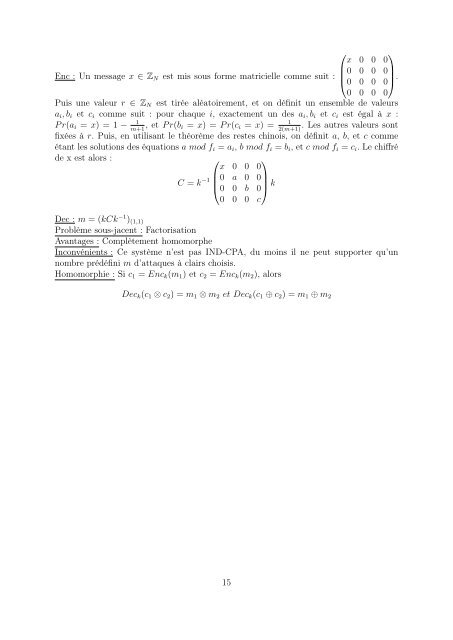rapport_M2_09_2012
rapport_M2_09_2012
rapport_M2_09_2012
You also want an ePaper? Increase the reach of your titles
YUMPU automatically turns print PDFs into web optimized ePapers that Google loves.
⎛ ⎞<br />
x 0 0 0<br />
Enc : Un message x ∈ Z N est mis sous forme matricielle comme suit : ⎜0 0 0 0<br />
⎟<br />
⎝0 0 0 0⎠ .<br />
0 0 0 0<br />
Puis une valeur r ∈ Z N est tirée aléatoirement, et on définit un ensemble de valeurs<br />
a i , b i et c i comme suit : pour chaque i, exactement un des a i , b i et c i est égal à x :<br />
P r(a i = x) = 1 − 1 , et P r(b 1<br />
m+1 i = x) = P r(c i = x) = . Les autres valeurs sont<br />
2(m+1)<br />
fixées à r. Puis, en utilisant le théorème des restes chinois, on définit a, b, et c comme<br />
étant les solutions des équations a mod f i = a i , b mod f i = b i , et c mod f i = c i . Le chiffré<br />
de x est alors :<br />
⎛ ⎞<br />
x 0 0 0<br />
C = k −1 ⎜0 a 0 0<br />
⎟<br />
⎝0 0 b 0⎠ k<br />
0 0 0 c<br />
Dec : m = (kCk −1 ) (1,1)<br />
Problème sous-jacent : Factorisation<br />
Avantages : Complètement homomorphe<br />
Inconvénients : Ce système n’est pas IND-CPA, du moins il ne peut supporter qu’un<br />
nombre prédéfini m d’attaques à clairs choisis.<br />
Homomorphie : Si c 1 = Enc k (m 1 ) et c 2 = Enc k (m 2 ), alors<br />
Dec k (c 1 ⊗ c 2 ) = m 1 ⊗ m 2 et Dec k (c 1 ⊕ c 2 ) = m 1 ⊕ m 2<br />
15







